Let’s Play Together!
Reflecting SEGA’s build-anything, arcade-rich 90s heritage, the Saturn boasts a plethora of hardware expansion options that enhance the end-user experience. Complimenting a healthy number of mainstream accessories is an even greater number of peripherals that are, to put it generously, niche. SEGA’s happiness to produce all manner of optional hardware bred a reality of fringe devices that were ultimately so underutilized as to be a curiosity for all but the most discerning Saturn gamers. This can be said of word processors, E-Book readers, photo decoders, and the subject of this piece: the ill-fated Taisen (system link) Cable.
ORIGINAL ARTICLE BY PETER MALEK of SEGA SATURN, SHIRO!
対戦: Taisen. Translated, ‘Taisen Cable’ is Battle Cable. Depending on context, ‘Tai’ is used as either a preposition or a noun and can mean ‘versus, pair, opposition’. ‘Sen’ is a noun, and translates to ‘war, fight, or battle’ (Sakura Taisen, for instance, translates to Sakura Wars). So, the Japanese Saturn Taisen Cable could properly be called the ‘Saturn Vs. Battle Cable’ in English.
But… what is it, exactly?
The Taisen Cable is a system-to-system interface cable. In the pre-internet era, this physical connection linked two Saturns, facilitating lag-free competitive or cooperative gameplay in compatible games. The advantages are obvious: do away with restrictive, processor-intensive split-screen affairs and say hello to full-screen, full speed 2 player gaming! The disadvantages center around two Saturns, two displays, and two copies of the same link-compatible game are required in the same physical area, as is of course the cable itself, and two human* players. Outside of tournaments or get-togethers, it is seldom that all of these conditions can be satisfied, especially with today’s dwindling number of hardcore Saturn adherents. In concert with the Saturn’s various modems, The Taisen Cable solution is the closest mid-90s equivalent to today’s ubiquitous online gaming paradigm.
Officially released only in Japan, the cable could be purchased right at the Saturn’s 1994-11-22 launch. Somewhat tragically, the first link-compatible title, Hyper 3D Battle Taisen Gebockers, was published on 1996-02-23 – a full fifteen months after the cable’s release! The cable was initially marketed in the Saturn’s golden scheme packaging and again when SEGA updated their branding to red and white. Through the system’s retail life, it carried part number HSS-0107, and featured proprietary couplings which fit into the Saturn’s seldom-used ‘Communications Connector’ port on the rear of the console. There were even some off-brand cables produced by third parties, again only available in Japan. Over and above standalone availability, the cable could also be purchased in special box sets of the GunGriffon 2, Steeldom and the aforementioned Gebockers game releases. Outside of linked gaming, the Cable serves no other function.
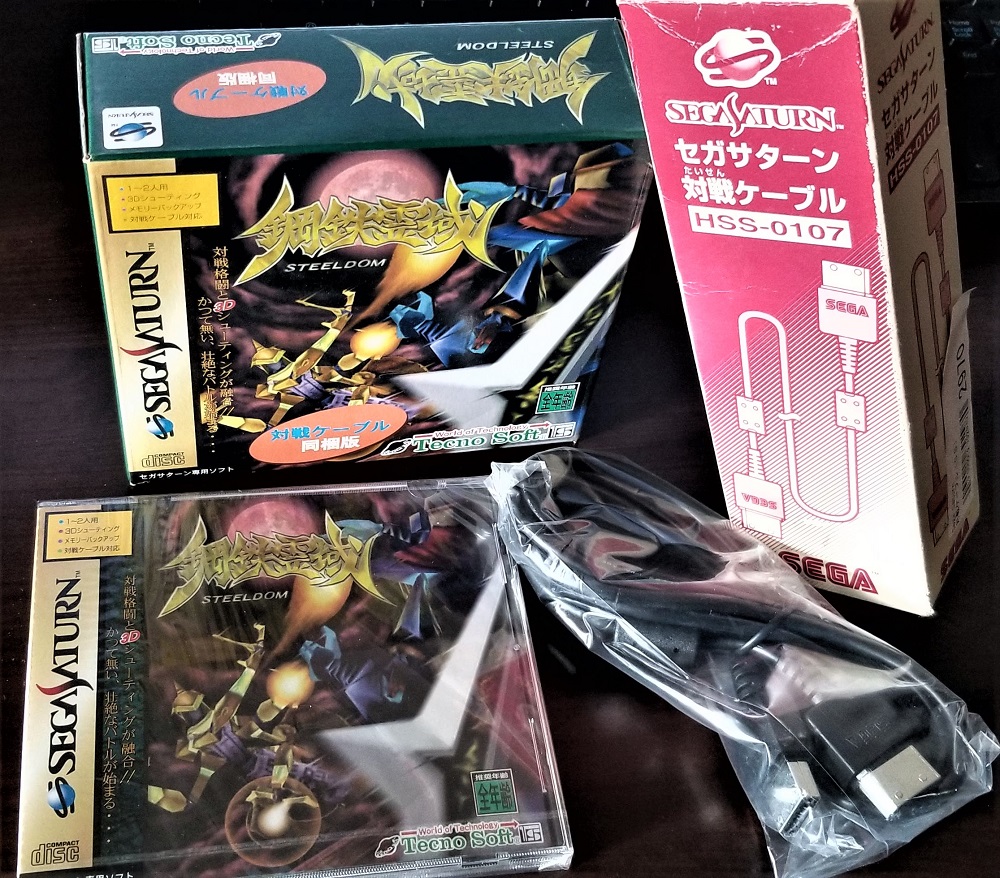
The Taisen Cable measures roughly six and a half feet / 2 meters in length. As with nearly all Saturn peripherals, it is region-free and will work with any combination of two Saturn units from anywhere in the world, including consoles from partner brands Victor / JVC, Hitachi, and Samsung.
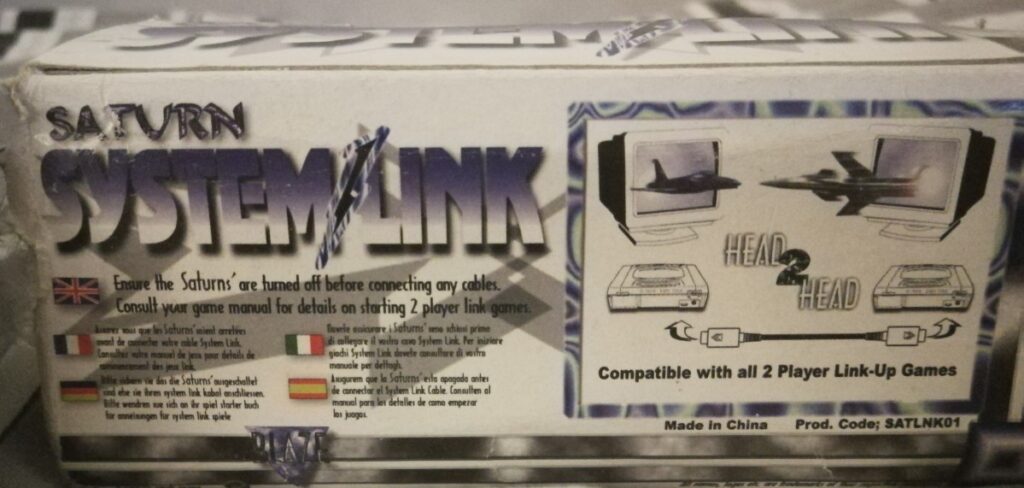
In terms of compatible titles… the Saturn’s library ultimately closed out at well over a thousand unique titles. Out of these thousand+ releases, the final tally of games that officially make use of the Taisen Cable stands at… six. Absolutely tragic, considering the vast number of games that could have benefitted from support for a vastly enhanced multiplayer experience. Further still, of the six titles, one single solitary game comes from SEGA themselves. With respect to multiplayer, the Taisen Cable clearly took a backseat to SEGA’s web-based ventures.
Here, we take a look at the six games that make use of the Cable, in released date order:
Hyper 3D Taisen Battle Gebockers (Riverhillsoft, 1996-02-23)
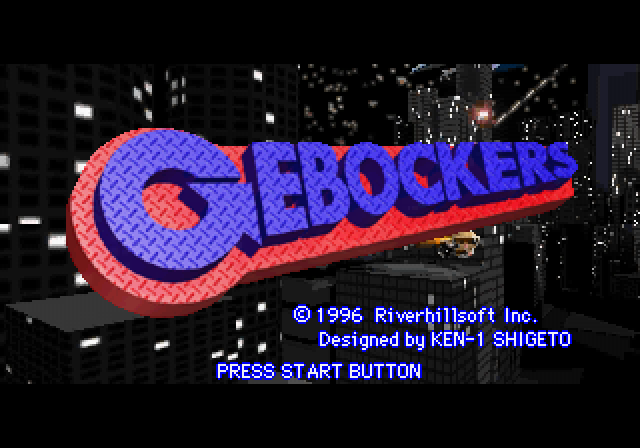
Gebockers is a curious release by Riverhillsoft – a small software house responsible for porting two Ogre Battle titles to the Saturn. Essentially a head-to-head game in a similar vein to Virtual On but featuring ‘cute’ characters and a wacky storyline, the title became the very first to use the Taisen Cable.
In a distant future, malevolent high-AI robots known as Strikers appear and begin menacing society, committing all sorts of ever-escalating crimes. To combat the Strikers, authorities create units known as Blockers (straight translation is Bockers; there is no L in the Japanese language) and mark each cohort of units with a letter designation. Each successive series of Blockers is an improvement over the previous, and is able to manage more and more dangerous transgressions. Around the time the sixth generation of Blockers – F-Units (Fe-Blockers) – were produced, the Strikers staged a surprise attack that not only wiped out all previous lines of Blockers but also hacked into the F-Units’ AI, effectively taking them over. Now, the Strikers have a legion of the most powerful Blockers as their foot soldiers. Panicked, the government orders the deployment of the experimental next-generation G-Units, the Ge-Blockers, to counter the Fe-Blockers and eventually take on the Strikers.
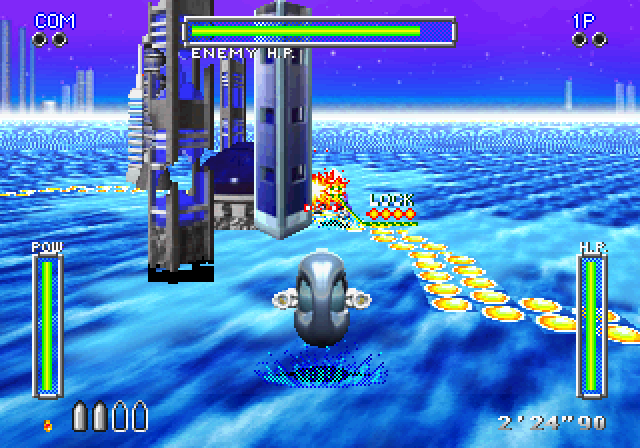
The game doesn’t take its ridiculous story at all seriously, employing a very cartoony, childlike look. The story isn’t English-friendly but this doesn’t detract from the enjoyment of the title. On offer is a solo campaign where a single player works their way through the roster of opponents before facing off with the head Striker to resolve the storyline, as well as both split screen 2-player versus mode and the full-screen link game. Of course, a competitive 2-player game is far more fun than playing against the CPU. The horizontal split screen game is done well with no noticeable performance loss, but the link game is naturally far superior if for no other reason than each player enjoys their own, full screen.
Battles unfold in large, flat, bordered (no ring-outs) asymmetric arenas that make use of the Saturn’s infinite plane to create smooth and stable graphics. Arenas are littered with some geometry – pillars, trees, shrubs and the like – that can sometimes provide both a hiding spot and cover from enemy fire. All in-ring geometry and the characters themselves are made of sprites, and this overall simplicity makes for a fast framerate. Levels are colorful and the presentation has a cartoony vibe. Sound is also decent, if unremarkable.
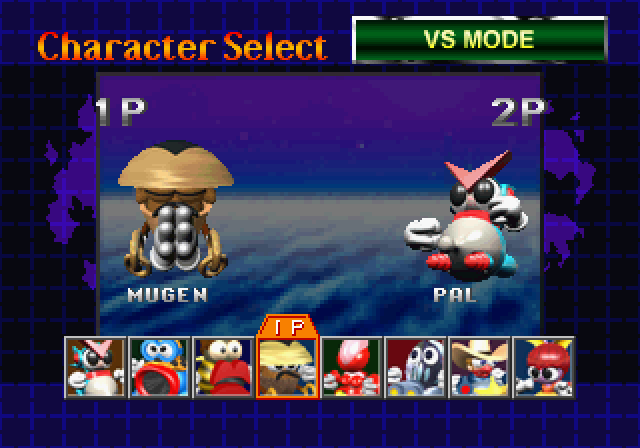
The game employs tank controls to move, with double-tapping forward or backwards producing quick dashes. L and R triggers provide lateral movement. Each GeBlocker possesses both a life bar (deplete your opponent’s bar to win) and a charge bar (using weapons diminishes this bar). Whilst the charge bar will eventually replenish, players can press A+B simultaneously to recharge it sooner, at the cost of being able to move. Thus, some strategy must be employed as Riverhillsoft wisely curtailed trigger-happy sensibilities. Geblockers can also jump, and some can even hover briefly. On-screen arrows orient players to their opponent’s position, and there is even a cascading lock-on feature: first level lock is a distance lock with a fair chance of landing a hit, all the way up to a fourth level lock, which guarantees a proximal strike.
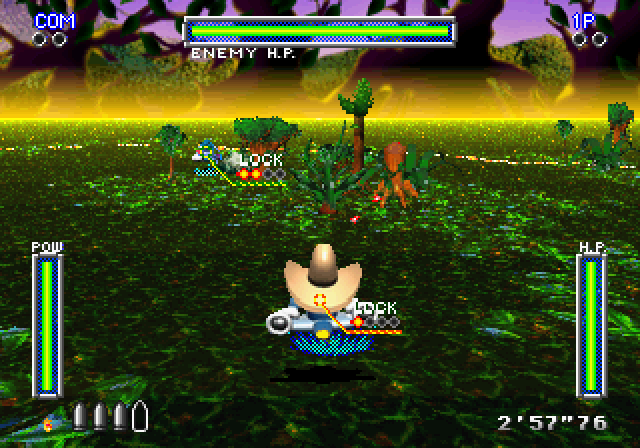
Overall, this is an average game. The one player mode, whilst mildly entertaining, does not hold interest for long. Two player contests are better, and link games are the best yet. Hyper 3D Taisen Battle Gebockers is a B- overall effort, and definitely recommended only to those wishing to take advantage of link play, which is its strongest feature. Those without the means to play in link mode will not enjoy it nearly as much.
Hyper Reverthion (Technosoft, 1996-06-07)
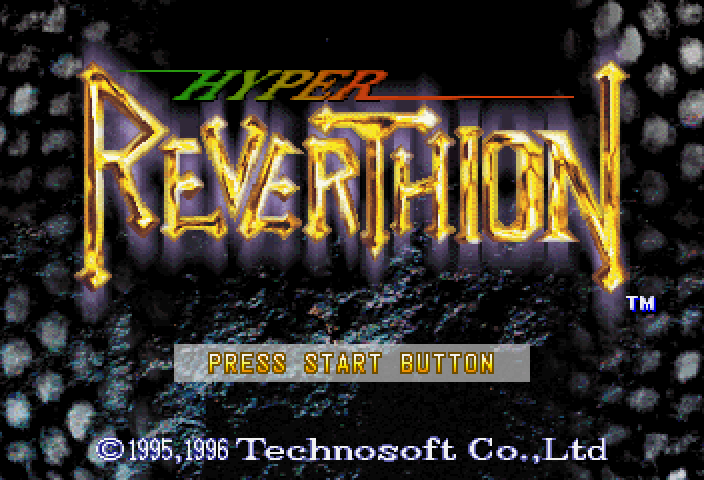
Hyper Reverthion hails from the house of Technosoft, makers of legendary Saturn titles Blast Wind, ThunderForce V, and others. Like Geblockers, it plays as a one-on-one Virtual On: Cyber Troopers style versus game with the mechs being natural creatures: crabs, sharks, butterflies and so on, but unlike Geblockers, characters are fully 3D. The player selects one of eight characters (the final boss is eventually unlockable as well) and battles their way through the rest of the roster before finally confronting the game’s end boss. Each character has their own arena as well as motivation for competing in the tournament. For instance, Teag is a young archaeologist who has found one of the legendary heavenly stars on one of his recent digs. Now, with his tiger-like mech, he is searching for more of them. Zild is a healer seeking the cure for his sister’s mysterious illness; his mech is a shark. Regardless of character selected, the player guides their chosen fighter in search of Sentien, a mythical paradise and home to a legendary secret power. He who finds Sentien gains control over all creation – and the title of The Reverthion. The Japanese-heavy story mode will prevent most fans from understanding what is going on, unfortunately.
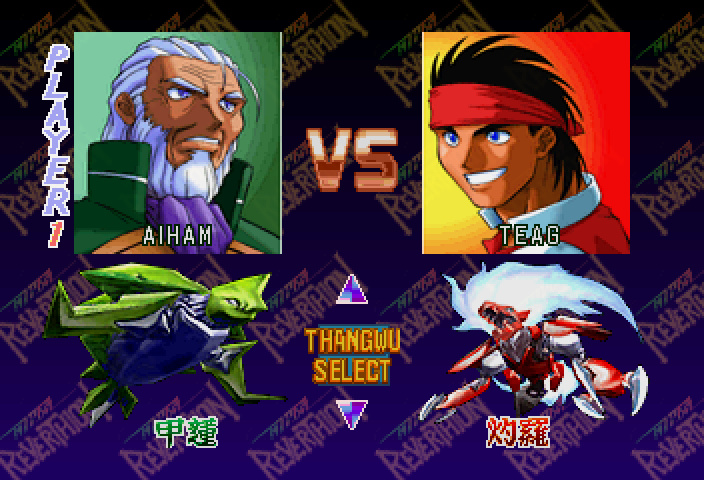
The gameplay is exceptionally average at best, and admittedly, a little bit frustrating at times. Old-skool tank controls are employed, mainly due to the lack of control pads featuring a second stick during this time period. Ultimately the controls aren’t overly bad: the camera is always positioned behind the player, and the control scheme is very reminiscent of contemporary third-person perspective 3D games such as Virtual On and Tomb Raider. All mechs share a standard set of moves, and each has a couple of unique specials pulled off combo-style. Rolls and boosts are easily executed, and overall movement is decent, if slow. The playfields are flat, open arenas with minimal, simplistic architecture for added strategy. Missing is a radar display showing the direction of your opponent; losing sight of the opponent leaves the player not only vulnerable but also somewhat disoriented. Lastly, is it not possible to move and fire at the same time (arguably a strategic gameplay element once the player gets used to this), and ring-outs are a factor for the unwary gamer.
The game’s presentation is very nice, but in-game graphics have a very first-generation look. The 2D background scenery comprises of a single static heavily pixelated image. The 3D player models are decent if unremarkable, though they animate well. A good 15% of the top of the screen is reserved for power meters and the like, reducing the amount of gameplay for the Saturn to display. The greatest graphical feat here is the game’s frame rate – Technosoft’s goal was to hit a constant 60 fps, and this was achieved, perhaps at the expense of complex playfields and backgrounds. ‘Serviceable’ is the order of the day in terms of visuals.
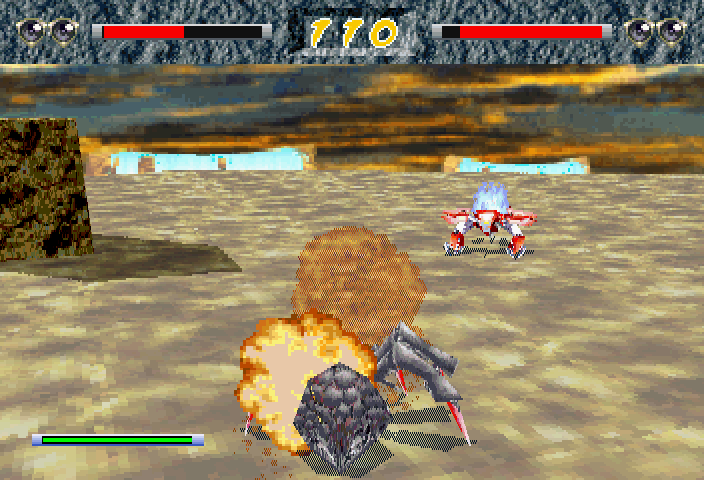
The soundtrack fares much better. Coming from TechnoSoft, much of it feels familiar and appropriately conveys a sense of tension, adventure, and liveliness. The soundtrack is CD-DA (Red Book standard audio) and can be played in a CD player in glorious high fidelity. The soundtrack is ultimately much more memorable than the game’s visuals.
The game is also 2P playable in split screen on a single Saturn, but the aspect ratio is maintained – meaning, the gameplay window is very small for both players. The 2P experience is much, much better in link play. Overall, Hyper Reverthion scores a C- for being a passable, if completely unremarkable and at times flawed experience. VERY dedicated Saturn – or indeed, Technosoft – fans will appreciate this; all others will see it for the barely average game it is.
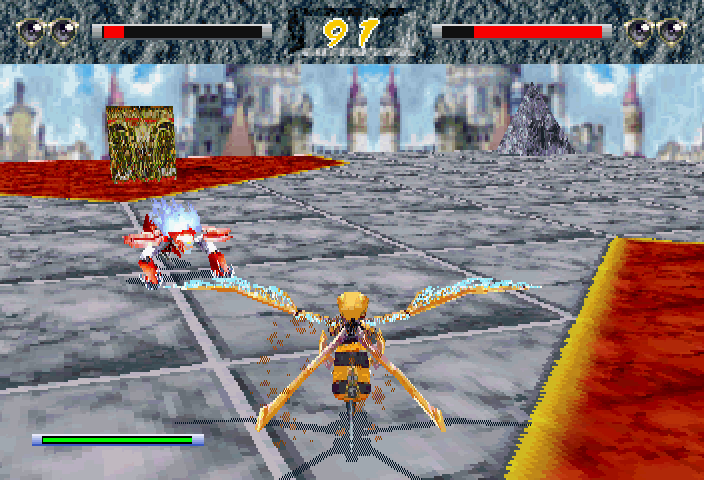
Fun Fact: Hyper Reverthion is a sort of ‘director’s cut’ of the PlayStation game Reverthion, which released exclusively in Japan in December of 1995. The PlayStation game looks a bit rougher than the Saturn edition (unable to do infinite planes, the PS’s flat arena floors are prone to polygon warping), and completely lacks link cable support.
Steeldom (Technosoft, 1996-09-06)
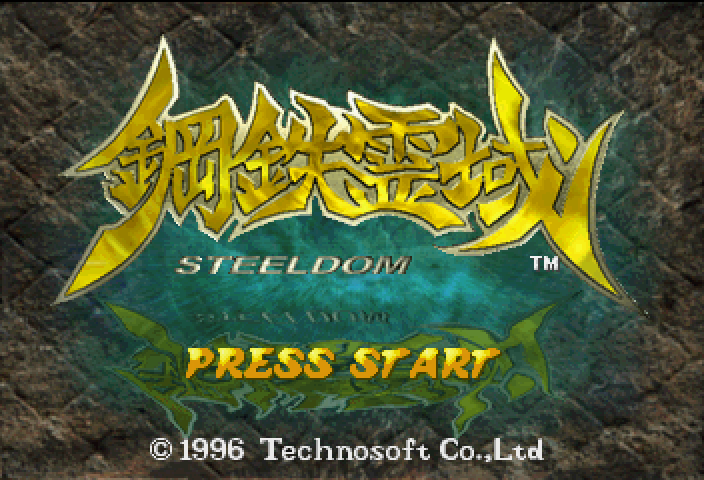
Steeldom is a spiritual sequel to Hyper Reverthion. Also from Technosoft, this is yet another one-on-one mech game, this time set in ancient Japan. A volcano has erupted and released the Mad Demon King, whose goal is world domination. Of course, he relishes pain and suffering (he should have bought himself a PlayStation for that, really) so to quench his bloodlust, he organizes a tournament for eight fighters to battle for the privilege of squaring off against him. As expected, each of the eight characters has a reason to be there – from Sorma the knight who is training to one day re-take his homeland from the forces that took it from him to the samurai Zerai, who has dedicated himself to his search for enlightenment. All of this will be lost on the non-Japanese speaking gamer unfortunately, but at the end of the day, Steeldom is a mech combat game; the story is superfluous.
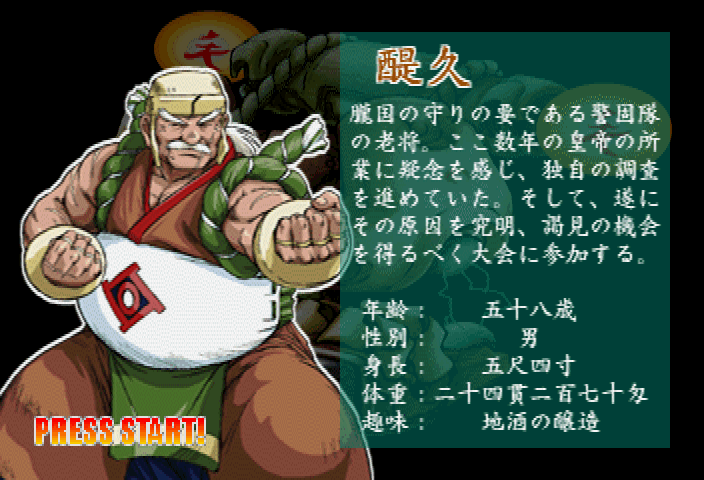
Being Technosoft’s second attempt at the genre, Steeldom features several improvements over Hyper Reverthion. For one, the player can press X, Y or Z at any time during battle to re-orient their mech to face their opponent – handy, yet the manoeuvre executes slowly. There is a very fast L and R dash, useful for a quick dodge, as well as a jump and hover option. Executing special moves is somewhat easier than in Hyper Reverthion, although specials drain a stamina bar which replenishes very slowly, encouraging only sporadic use of special moves. A boost dash has been added as well, allowing the player’s mech to rush forward and hopefully execute a close-range attack, or even knock their opponent off the battle platform for a quick win.
If you think Steeldom’s overall control description sounds an awful lot like Virtual On, you would be fairly correct: the games are very similar; Steeldom hit the Saturn two months before Virtual On did, although Virtual On did have an earlier arcade release.
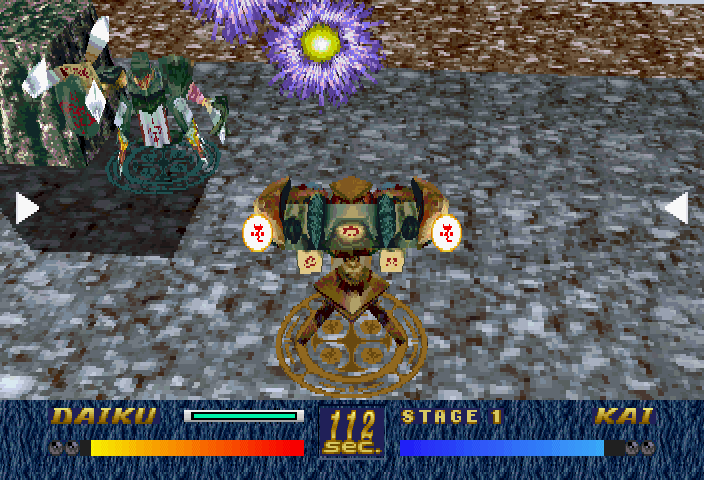
Visually, the game fares somewhat better than Hyper Reverthion. Backgrounds aren’t quite as pixelated anymore, and now feature several independently scrolling planes. The arenas continue to be relatively bare. The mech fighters, this time in humanoid knight form, feature quite a bit more geometry and sport tighter textures. Presentation is also nicer overall. There is occasional glitching when the mechs are too close to the sporadic blocks in the battlefield, but otherwise the polygons are solid. Like Hyper Reverthion, the game runs at 60 FPS, and whilst it isn’t the prettiest Saturn game around, it does look smooth.
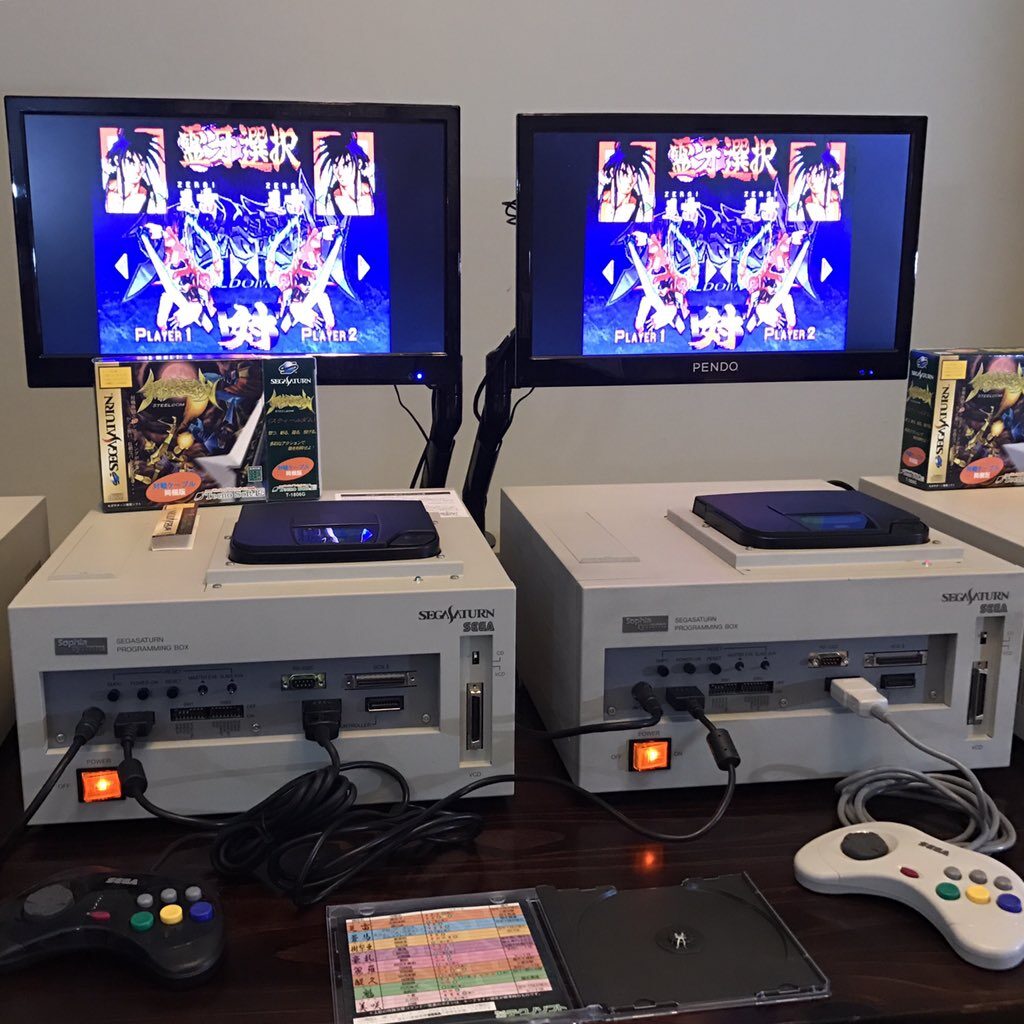
As with Reverthion, the game features a remarkably good Red Book Technosoft soundtrack – for better or for worse, the music is both games’ best feature. It should also be pointed out that both Hyper Reverthion and Steeldom have fairly steep learning curves. These are not button-mashers… but when playing head-to-head against a human in link-up mode, this matters far less.
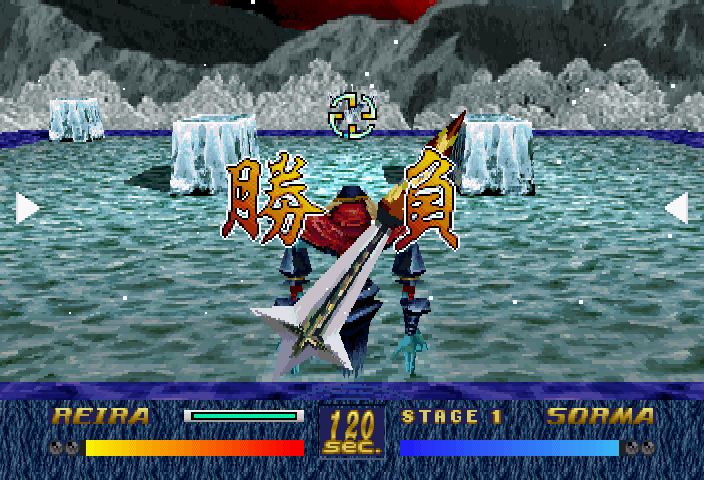
On the whole, Steeldom is an average game – very similar to and somewhat better than its predecessor. Link play is a definite boost to its shallow experience, but the game never truly gets above a C+ rating. Steeldom – like Hyper Reverthion before it – is best enjoyed by hardcore Saturn fans that don’t mind the learning curve, can look past the lack of depth in gameplay, dig Technosoft music, aren’t bothered by the Japanese text in the story mode, and can facilitate link-up play with their friends. A narrow slice of the gaming population indeed.
Daytona USA Circuit Edition (SEGA, 1997-01-24)
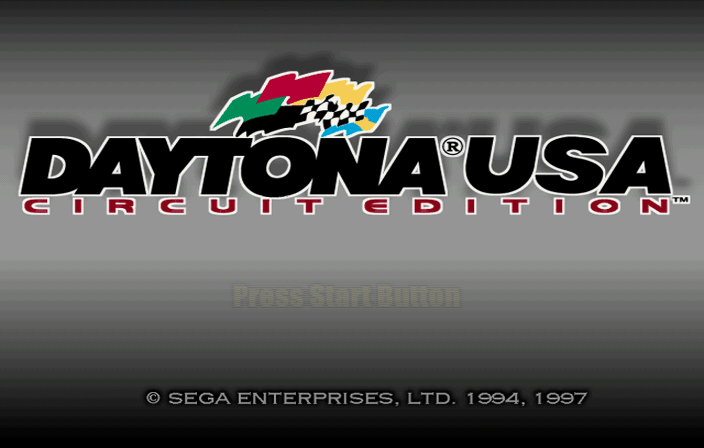
The first Daytona USA conversion, handled by AM2, was so roundly criticized that SEGA put forth a Championship Circuit Edition in mid-1996 exclusively in the West. This time, programming duties were handled by AM3, hot on the heels of their very successful SEGA Rally Championship conversion. Using the Rally engine, the team responsible for this reconversion continued to labor on the game after its western release, and a few more months in the proverbial oven culminated in the release of Daytona USA Circuit Edition. Aside from split screen 2 player racing that it shared with the western Championship Circuit Edition, this Japanese exclusive release also supports both the Japan-only SEGA Saturn Networks XBand Modem for online play as well as the Taisen Cable for full-screen local head-to-head.
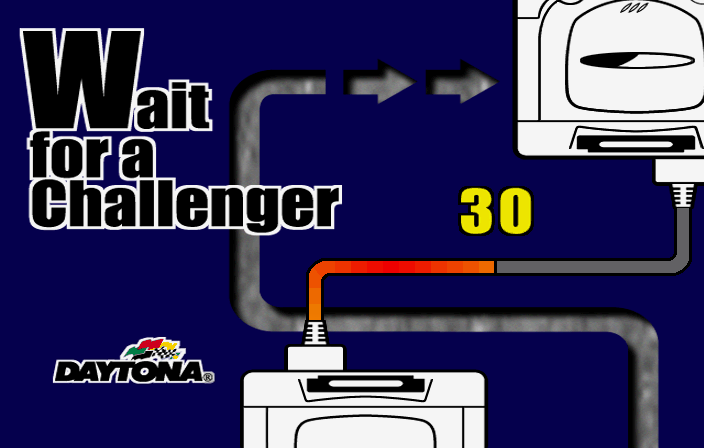
Multiple vs. gameplay options are available such as speed boosts, delayed starts, and various conditions to finish each race such as one player getting a certain distance ahead of the other. What’s more, there are also drone cars for both players to contend with on the racetrack, marking this as the closest one can come to experiencing an actual Daytona twin arcade in the home. The game continues to bear criticism for controls that are not quite as true to the arcade as the original conversion, but the myriad improvements in all other areas are undeniable. Also improved over the western CCE edition is the ability to choose from Remixed or Original music – featuring Mitsuyoshi’s (in)famous Daytoooonaaaa vocals. The draw distance has also been improved slightly, a few textures have been upgraded, and the odd bit of track scenery has been added in as well. Over and above the standard race times, races can also be enjoyed in the sunrise, evening, and night in this edition.
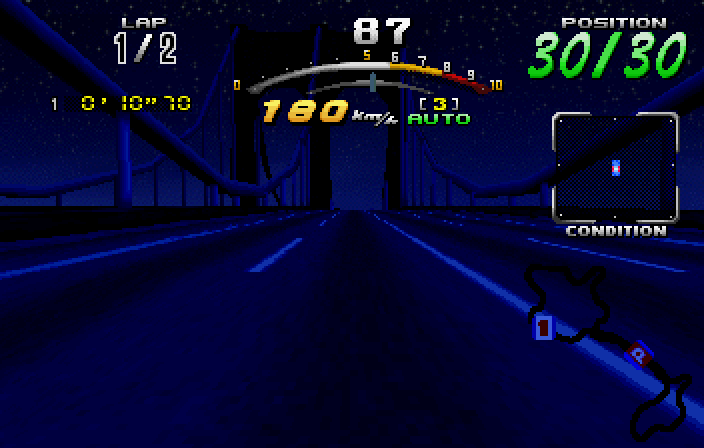
Grab a friend (an enemy will also do), two Saturns, two copies of Daytona USA Circuit Edition, two displays, two Arcade Racers (or 3D Control Pads), and the Taisen Cable (that’s a lot of equipment!), and experience the arcade at home… as close as is possible on the Saturn, anyways. Overall, if you are a fan of the second conversion of Daytona for the Saturn with its refined (tortured?) handling, this disc will give you plenty of new reasons to smile – especially when competing over the Taisen Cable. This is a solid B+ game, only prevented from reaching top tier status by the less-than-arcade-perfect controls.
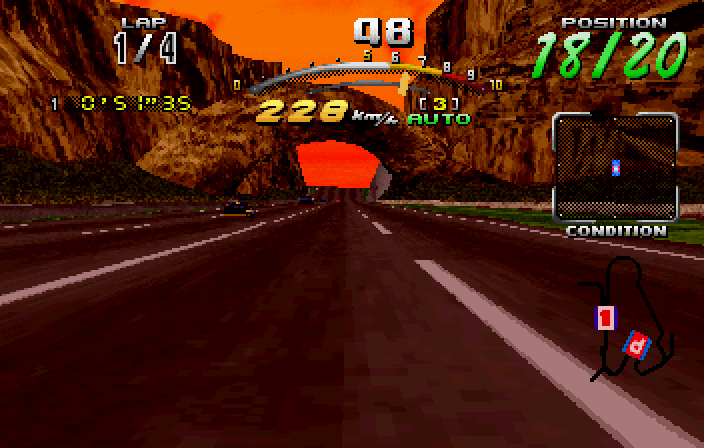
Sadly, Daytona USA Circuit Edition is the only version of the game to support the Taisen Cable. The 1998 North American exclusive release of Daytona USA: CCE NetLink Edition, whilst retaining most of the new features of the Circuit Edition, does not support the cable – possibly because the cable had no official release in the West.
Doom (Rage Software, 1997-07-11 Japan)
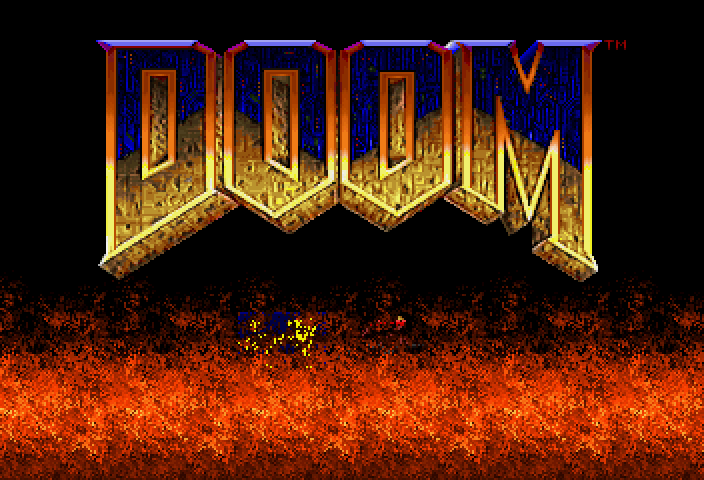
Doom started life on the PC and swiftly made an enormous impact on the videogame industry, popularizing not only the realistic 3D corridor genre but also networked cooperative and deathmatch modes. Taking on the role of an unnamed marine, the player starts out on Mars’ moon Phobos, tasked with containing an apparent invasion at the research facility there. Turns out the sinister United Aerospace Corporation has been running secret teleportation experiments on Phobos and inadvertently opened portals to Hell. Now, monsters and demons have overrun the outpost and must be stopped.
The North American version of Saturn Doom was the first regional version to market and, sadly, is missing Taisen Cable support. The subsequent European and Japanese versions had a bit more time to marinate and the link facility was added in. Doom features not only deathmatch mode but also a co-operative mode where two separate marines tackle the game’s levels. In co-op mode, it is possible to triangulate on enemies and whilst one marine draws attention, the other fires with impunity. It makes sense for both players to work closely together to destroy enemies. That said, nothing stops the two players from dividing tasks and heading off their separate ways in more complex levels for a very different experience. At the conclusion of each level, kills / pickups / secrets stats are displayed for both players. Conceptually, the Cooperative mode is excellent.
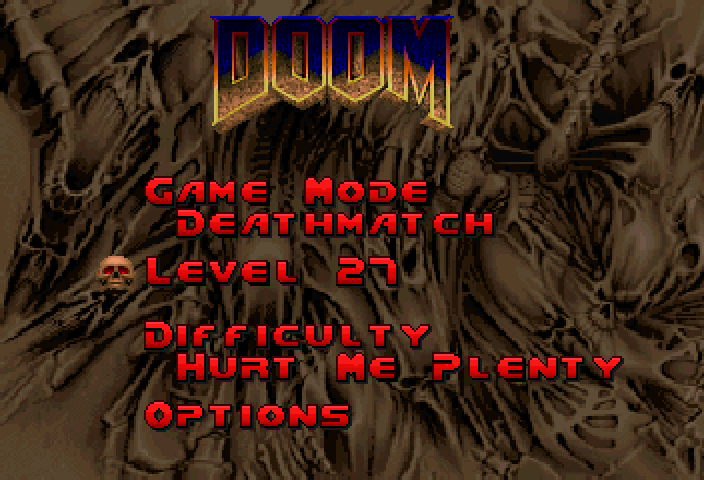
In Deathmatch, any of the levels can be selected as both players attempt to kill the other. Enemies are removed from this game mode, but pickups and environmental hazards remain. Using the wirefame map helps as the levels can be large, and it can take time to find your mark. Should all bullets be exhausted, fists are used to settle the contest.
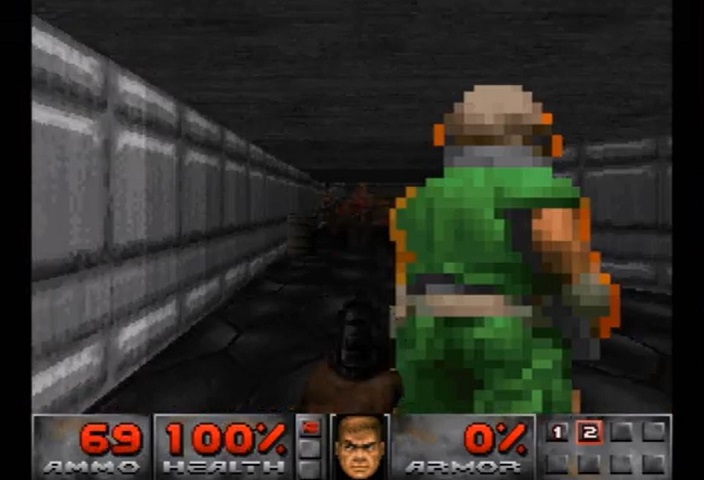
The game was initially programmed to take advantage of the Saturn’s unique architecture, but in a decision programmer John Carmack later conceded was incorrect, it was reprogrammed to run exclusively on the Saturn’s twin Super Hitachi 2 (SH2) chips. The Saturn’s powerful Video Display Processors (VDP) were left largely unused. This resulted in a very weak frame rate which tops out at 12FPS in the original Doom levels and struggles to hit 10FPS in the Doom 2 levels. This is tragic as the genre relies on a fast frame rate, and the game’s initial Saturn beta – prior to the switch to SH2-only – actually ran faster than the PlayStation game.
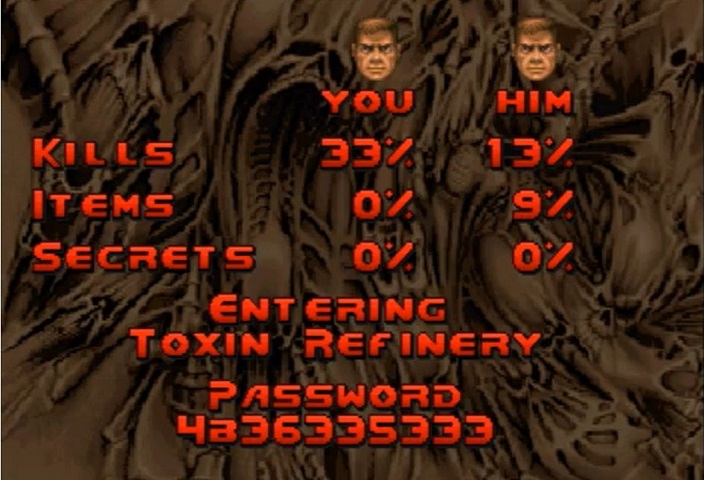
Still, Doom is Doom, and as unoptimized as the Saturn product is, there is a fantastic game buried underneath the mountain of programming shortcomings. Innovative features such as the multi-level nature of the worlds are present and correct on the Saturn version, and whilst the game studders, it does still play quickly. Today, the Saturn is certainly not the best way to experience Doom, and even in its time, Saturn Doom was lambasted for how it turned out… but it does scratch the Doom itch in a pinch.
Taisen Cable link modes are only available on the European and Japanese Saturn releases. The experience works similarly to the single player game – it runs slowly; however since each Saturn is rendering only one instance of the game, thankfully the framerate doesn’t dip any. Overall, the game scores a D: it is nowhere near as good as it could (should!) have been, the frame rate really chokes off much of the fun, and most contemporary versions were simply better. Even in terms of link play, the PlayStation port is a much better bet. It could have been an A+ game. Sad.
‘Fun’ Fact! Doom’s jewel case back inlay (US version) advertises link-up play despite the game not featuring it. Boo!
GunGriffon 2 (GameArts, ESP, 1998-04-23)
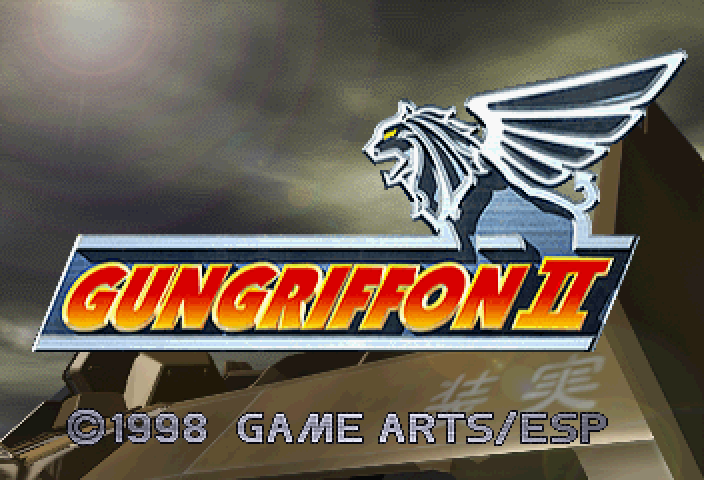
Game Arts’ sequel to their well-received original, GunGriffon 2 once again sees the player enter a resource-strapped, dangerous near-future world. Set in late 2015 (that’s nearly 20 years into the future from the game’s release date), the single player campaign remains as excellent as it was in the first game, although the visuals, sound, and control / gameplay are remarkably similar to those found in the franchise’s first entry. This is not necessarily negative – the first game looks and plays great – but expectations of audiovisual improvements in the sequel should definitely be tempered.
The first GunGriffon is regarded as one of the finest mech combat games of the era. During development, Game Arts weren’t shy about including support for an unusual peripheral for the game – the Japanese release makes use of the VCD Card for an exceptionally smooth, high quality FMV intro. VCD Card compatibility is dropped for the sequel yet the second game still raises the bar by including support for two even more obscure add-ons: the Taisen Cable and the Twin Sticks!
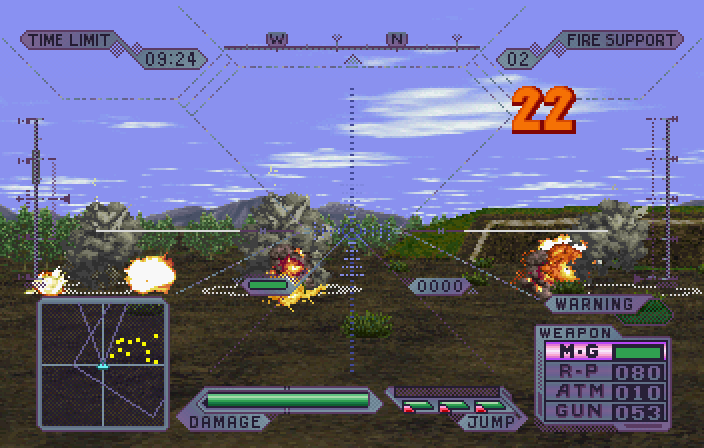
GunGriffon 2 introduces several multiplayer options for the first time in the franchise. First, the game can be played in either Single Seater or Double Seater mode. Single Seater is the one player mode whilst Double Seater requires two players to simultaneously control a single mech – one steers, the other operates the ordinance. This option is unique and surprisingly refreshing – rather than including a squished split screen vs. mode with degraded visual fidelity and potential slowdown, the single screen is preserved and both players must communicate and coordinate effectively to succeed, often in frantic gameplay situations. This is a novel 2-player offering to tackle the game’s story that will pleasantly challenge players used to straightforward head-to-head… but GameArts also has the head to head experience covered, thanks to the Taisen Cable.
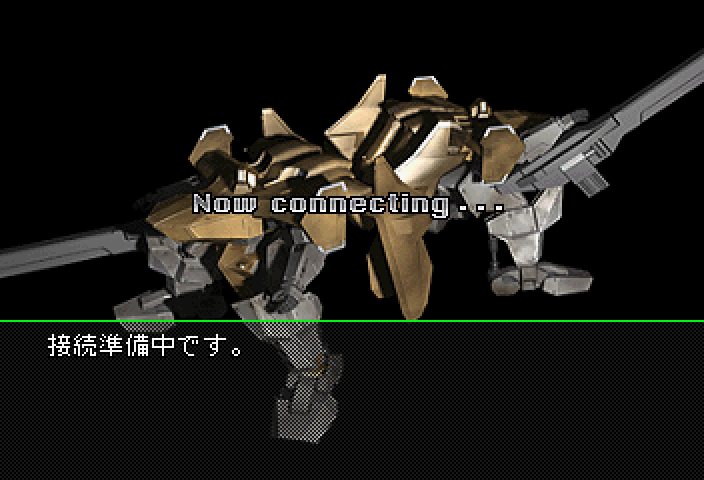
In Taisen mode, both players have their own screens to guide their mech to destroy their human opponent. Conceptually this sounds similar to – once again – Virtual On and the two TechnoSoft efforts, however the experience is more drawn-out, owing to the comparatively giant playfields, varied terrain architecture, and lack of an arcade-like timer clock. Head-to-head GunGriffon 2 contests are complex chess matches; Steeldom / Reverthion / Gebockers battles are quick bouts of checkers. Further, each player can make use of a pair of Twin Sticks for an absolutely smashing experience.
The game’s ultimate multiplayer expression comes in the form of link cable Double Seater play. Two players sit at each linked Saturn and operate their mech together for a truly unique, fantastic 4 player experience. There is nothing quite like the thrill of falling perfectly in tune with your human co-pilot to efficiently take down your opponents. The skill curve is long but never overly steep, ensuring 4-player link bouts remain fresh for a long time indeed.
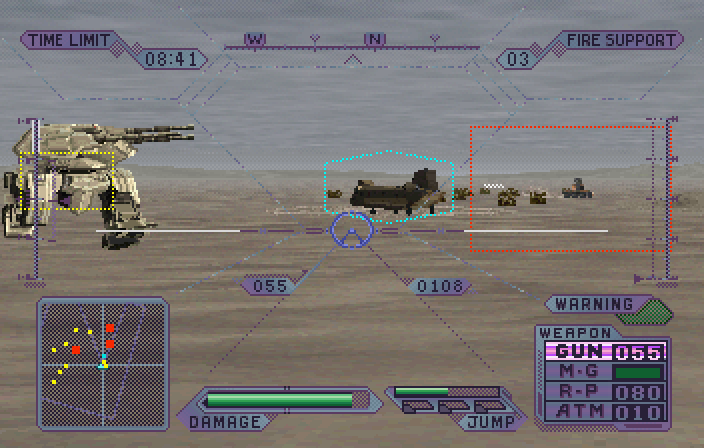
Game Arts employed the Taisen Cable in one more novel manner: when playing the story mode, either in Single Seater or Double Seater, the link cable can be used to display a broadcast-like, real time presentation on the second screen, of how the player(s) is(are) progressing. The changing camera angles and constant zooming would be inappropriate as a main game screen but make for a spectacular way to view the game for non-players. In this mode, the second Saturn acts as a sort of broadcast relay, solely for viewing the action from exciting angles and vantage points. Absolutely awesome.
GameArts must be commended for including support for both the Twin Sticks and the Taisen Cable. Whereas the single player campaign is very similar across the two games, the multiplayer options and Twin Stick support offered only in the sequel elevate GunGriffon 2 to new heights of excellence. Overall, this is a solid A- title, edging out Daytona CE as the best Taisen Cable game.
There they are… six titles in total; four being one-on-one mech type combat games. Of the lot, only GameArts’ GunGriffon 2 and SEGA’s own Daytona USA CE are worth the price of admission as link game experiences, and neither is an absolute AAA title.
What could have been…
SO MANY POSSIBILITIES. Online gaming on consoles was only nascent during the Saturn’s lifetime, so a gap did exist that the cable could have filled.
Had the Taisen Cable seen widespread release and software support, every single racing game could have conceivably seen an amazing 2-player (or more) mode. FPS games like Quake, Alien Trilogy or Hexen could have seen proper deathmatch modes. Games like Grid Runner would have certainly benefited, as would have the seminal Virtual On, whose sequel did indeed feature Dreamcast Taisen Cable support. Whilst practical constrains would have remained as limiting as they are today, there is no doubt that this would have been a strong differentiating feature compared to the PlayStation (Sony also offered their adherents a link cable) and Nintendo 64 (which featured no link facility at all). As time went on, SEGA positioned the Saturn as the hardcore gamer’s machine against the populist PlayStation and the family friendly Nintendo 64. Robust Taisen Cable support would have certainly underscored that ‘hardcore’ identity.
Other applications for the Taisen Cable that never came to fruition: chaining multiple Taisen Cables together for even more multiplayer gameplay, or even the transfer of save files from one Saturn to another.
The Games that Never Made It
The Taisen Cable garnered sufficient interest from various developers to – at the very least – explore the possibility of implementing link play in their games. Here are some that never made the cut:
Hexen (Raven Software, 1997-03-21 in NA and EU, 1998-03-26 in JP)
The most promising title in this group, Hexen was initially planned for Taisen Cable support. This was eventually dropped for reasons unknown, although programming deadlines and lack of marketing for the cable are likely culprits. Indeed, the PlayStation and Nintendo 64 versions of the game feature no link option of any kind. That said, link play code was actually written into the Saturn game, but never fully fleshed out – and what was ‘meant to be’ can luckily be accessed via a secret cheat menu! Entering a secret cheat code activates a list of debug features, including link up mode! Once selected, the Saturns attempt to link, and the game presents various choices. Players select type of game – deathmatch or cooperative – and the choice of maps. Each player chooses their fighter class and away they go!
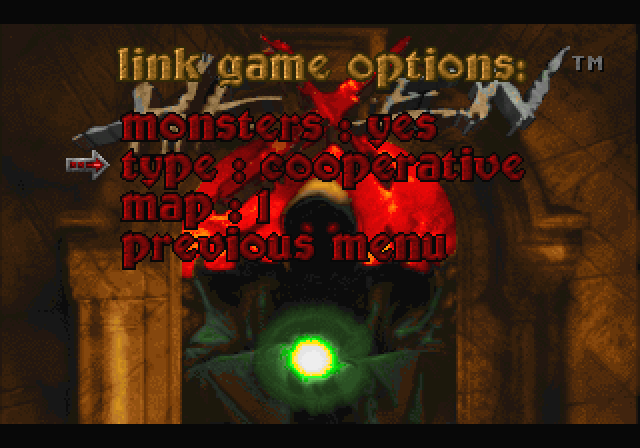
It quickly becomes apparent why link play was suppressed in the final product. The deathmatch is a buggy experience running at a heavily inconsistent – at times, stunted – frame rate with lines of code displaying in the upper portion of the screen for both players. The frame rate truly borders on making the game unplayable, alternating between being nearly as smooth as the single player game to being so jerky one wonders if the game has crashed. Still, hardcore players will persevere. However, the deal breaker that renders the entire experience bitterly useless is that the two players cannot actually see or interact with each other – the best that is achieved is seeing evidence of the other player picking up icons or opening doors in the vicinity. It is not possible to see, interact with, or harm the opponent at all. Thus, Hexen’s link play implementation is incomplete and, although the game will actually link, it is nothing but a novelty to get running in link-up mode.
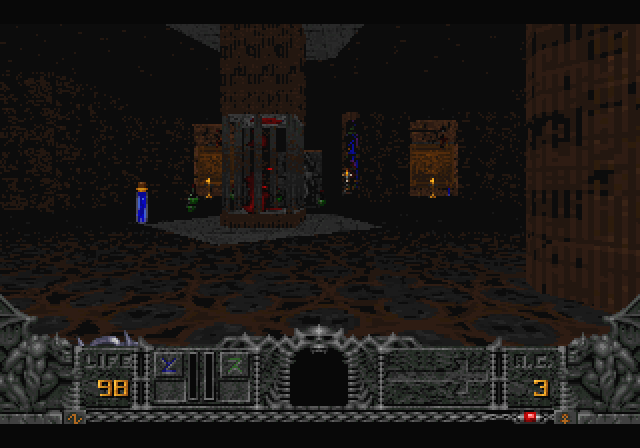
To access the cheat menu that unlocks Hexen’s Taisen Cable option, enter Up, Down, Left, Right, Y, Y, Z, Z, A, X, Up, Down, C, B at the game’s option menu.
Independence Day
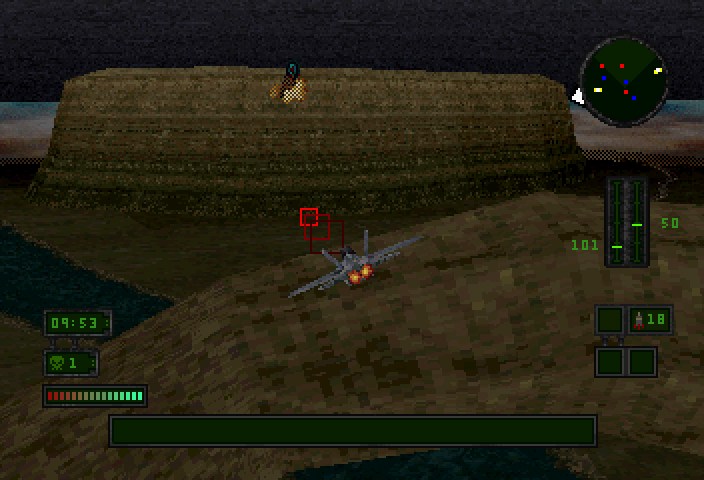
The PlayStation version supports that system’s link cable. The Saturn version was clearly planned for link play, however, the option was never implemented and is not found in any regional version of the game. It was possibly cut shortly before release however, as the US manual includes instructions on setting up Saturn link play, and includes appropriate screenshots. Perhaps leftover code still exists in the game, similar to Hexen – but as yet, this has not been uncovered. That said, a variety of publications of the time, including Britain’s Official SEGA Saturn Magazine, have repeatedly reported the Saturn game capable of link play. It is entirely possible that early pre-release or Alpha builds of the game exist where link functionality has not yet been removed.
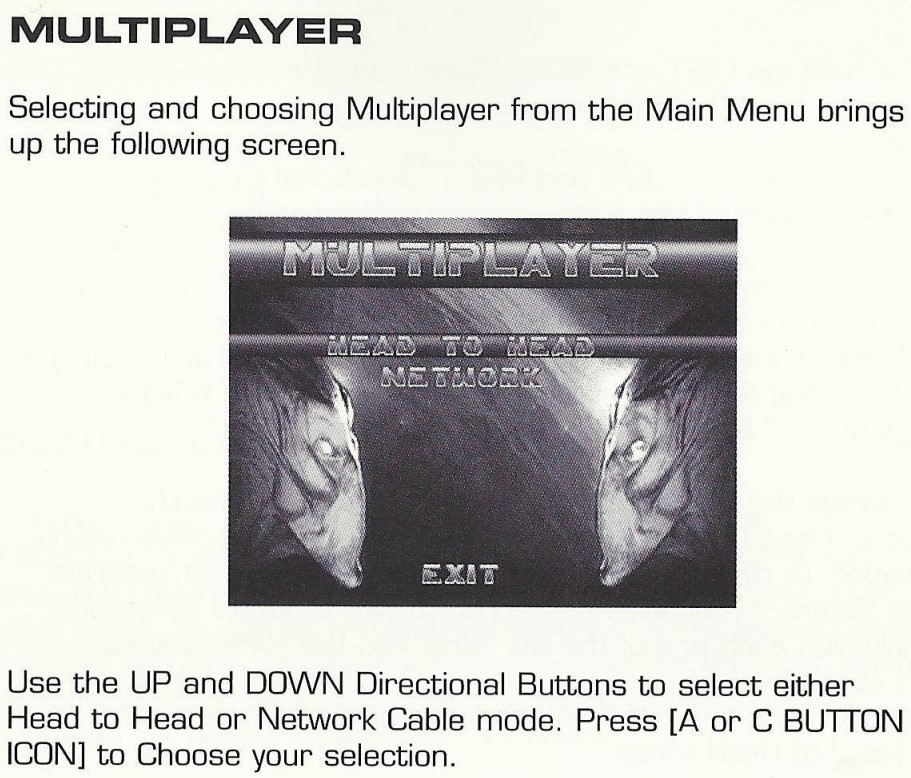

Various versions of Daytona USA
The Japan-only Daytona USA: Circuit Edition is the only Saturn Daytona game to feature Taisen Cable support. The North American CCE NetLink Edition does not support the cable, instead offering NetLink direct-dial modem play (technically still playable today). The original Championship Circuit Edition features neither online nor net play, but it was the first Saturn Daytona to introduce multiplayer via a split screen. The original Daytona USA conversion featured no multiplayer of any kind.
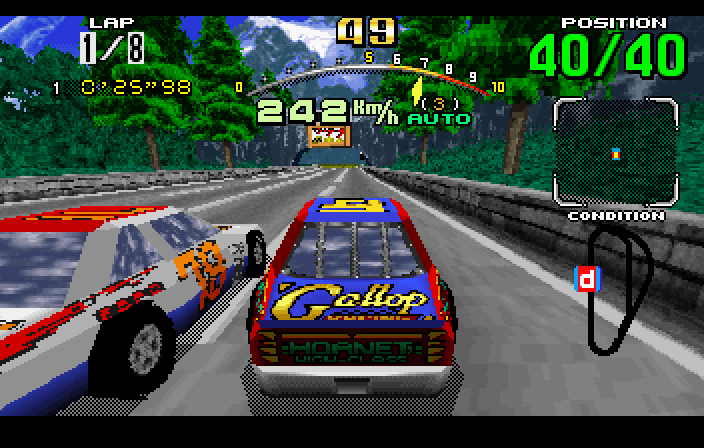
There are internet whispers that the obscure Japanese variant of the first game, Daytona USA Hibaihin Mihonban potentially supports the Taisen Cable. This unusual edition was akin to a promotional version of the game – it is extremely similar to the retail edition with only minor differences: for instance, it is possible to set lap times anywhere from 1-99 for all tracks, and the game forces a soft reset upon completing a race. Otherwise, the game appears indistinguishable from the standard Daytona USA release. Sadly, all efforts to locate a link mode in this curious ‘demo’ game have been unsuccessful.
Psygnosis Ports
A large number of Psygnosis’ early PlayStaion games feature Link Cable support, and many of these titles were eventually ported to the Saturn. However, converting software house Tantalus did not include any of the link-up features in the Saturn games. Shame… WipE’out” would have been very nice in head to head.
PlayStation Link games that have non-link Saturn equivalents / Link Cables across the Fifth Generation
Across the Big Three fifth generation consoles, only the Saturn and PlayStation supported a system link cable. Nintendo did not feature any type of system link facility at all, instead relying on being the only console to feature four controller ports to facilitate the multiplayer experience (both Sony and SEGA would offer multi-taps to increase the number of controllers past the N64’s limit of four). Like SEGA, Sony swiftly ceased promoting their link cable, as practicalities suppressed the cable’s sales. Nevertheless, depending on source, the PlayStation wound up with between 40 and 50 link cable compatible games. On the other hand, SEGA’s full-screen multiplayer offering proved far stronger across modem-compatible games, something the PlayStation would not experience until the limited network experimentation on the PS2.
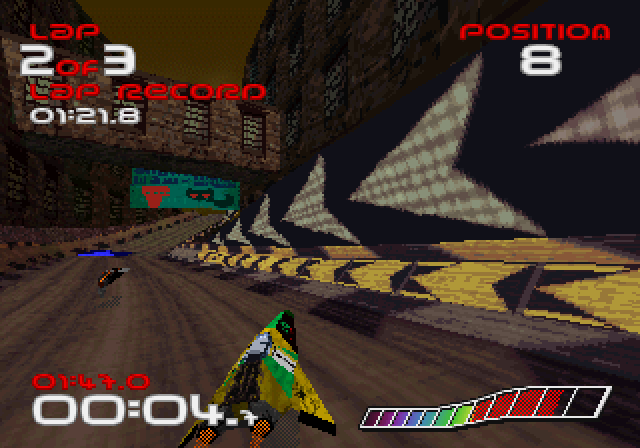
The following lists games available across both the Saturn and PlayStation, where link cable support exists on the PlayStation but does not on the Saturn.
- Andretti Racing
- Assault Rigs
- Destruction Derby
- Independence Day
- Krazy Ivan
- Road ‘n Track Presents: The Need for Speed
- WipE’out”
- WipE’out” XL
Five of the eight titles are Psygnosis games, which were generally ported to the Saturn by Tantalus.
On the reverse, out of the Saturn’s six officially-supported games, Steeldom and Reverthion are available on the PlayStation as well – and neither supports Sony’s link cable. Further, a PlayStation version of Hexen exists, which likewise does not support any link play. The PlayStation also features a game from the Duke Nukem franchise which supports link cable play, whereas the Saturn version is NetLink compatible.

A Saturn fan since the beginning, Peter plays Saturn almost exclusively. For Peter, Saturn represents a moment in time where 2D games were at their best, 3D was just rising, and fascinating gaming ‘firsts’ were commonplace. There are very few Saturn games that Peter cannot find some enjoyment in!

